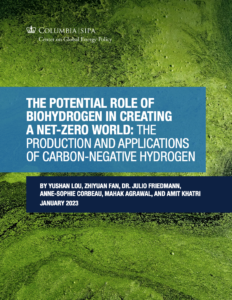Full Title: The Potential Role of Biohydrogen in Creating a Net-Zero World
Author(s): Yushan Lou, Zhiyuan Fan, Julio Friedmann, Anne-Sophie Corbeau, Mahak Agrawal, and Amit Khatri
Publisher(s): Columbia SIPA Center on Global Energy Policy
Publication Date: January 9, 2023
Full Text: Download Resource
Description (excerpt):
This report, part of the Carbon Management Initiative at the Center on Global Energy Policy, explores the current state of play for biohydrogen (Bio-H2) and its potential contribution to decarbonization efforts. The report begins with an analysis of the varying definitions and categorization of Bio-H2 in the literature, which may relate to its classification as both a hydrogen and a bioenergy with a diverse selection of sources and manufacturing pathways. Next, it assesses the crucial question of Bio-H2’s carbon intensity, which has additional specifications to those of blue hydrogen (defined as hydrogen manufactured from natural gas with carbon capture and storage [CCS]) and green hydrogen production, including land use, land use change, use of dedicated fuel crops (and associated land use issues), status and footprint of wastes (agricultural, forestry, and municipal), and avoided or reduced methane emissions. The report shows that if the biomass feedstock is not carefully selected and the energy consumed during its processing is not closely monitored and controlled, Bio-H2’s carbon footprint can potentially exceed that of fossil-based hydrogen today. Therefore, to avoid any potential negative climate impacts from utilizing Bio-H2, the assessment and governance of biomass feedstock for Bio-H2 manufacturing is critical.
